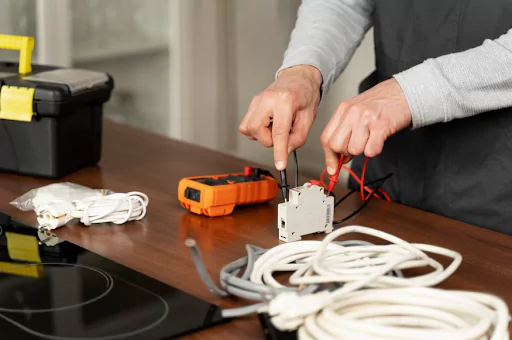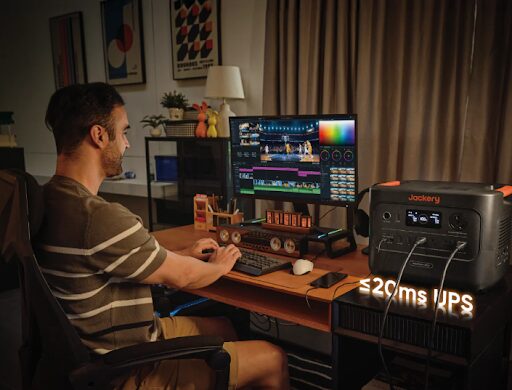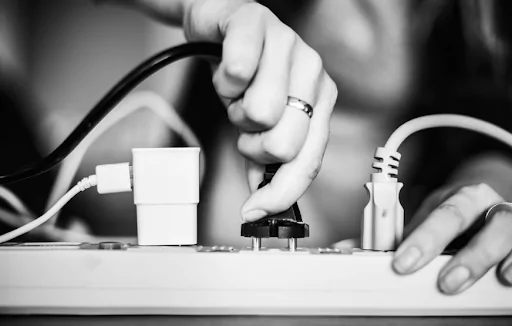Storms, blackouts, and grid failures can lead to overloaded circuits, leaving you without power when you need it most. That’s where a Jackery portable power station steps in. Acting as a battery backup for home power outages, it keeps lights on and appliances running without overloading the wiring of your home. To make your battery backup system sustainable, you can pair it with a foldable solar panel for renewable, off-grid power during extended power outages.
This guide highlights the common causes of overloaded circuits and how switching over to your Jackery for uninterrupted power will keep your home, phone, and fridge running.
What is An Overloaded Circuit?
An overloaded circuit occurs when too many electrical devices draw more power than the circuit is rated to handle. Each circuit in your home is designed to carry a specific amount of current—usually 15 or 20 amps—and exceeding that limit causes the wiring to overheat. This can trip the circuit breaker as a safety measure, but in more severe cases, it may lead to damaged wiring or even a fire.
Understanding what an electrical overload is and how it affects your system is essential for preventing serious hazards. Recognizing the signs early and managing your home’s power usage can protect your appliances, prevent frequent breaker trips, and help maintain a safe electrical setup.
Common Causes and Symptoms of Overloaded Circuits
Understanding the causes and symptoms of an electrical overload is essential to prevent serious safety risks. Here is a detailed explanation of the common causes and symptoms of an overloaded circuit.
Common Causes of an Overloaded Circuit
- Too Many Devices on One Circuit: Plugging multiple appliances into the same outlet or power strip can exceed the circuit’s capacity. For example, using a microwave, toaster, and coffee maker on the same kitchen circuit can quickly lead to an electrical overload, causing an overloaded circuit.
- High-Wattage Appliances Drawing Too Much Power: Devices like space heaters, air conditioners, hairdryers, and irons use a lot of electricity. If these are run simultaneously on the same line, they can cause an electrical overload, tripping the breaker.
- Outdated Wiring Systems: Older homes often have circuits that weren’t designed for today’s power demands. These systems are more vulnerable to overloaded circuits, especially when modern appliances and electronics are used heavily.
- Faulty or Damaged Wiring: Frayed, exposed, or poorly installed wires can increase resistance and generate excessive heat, pushing the circuit beyond its safe operating limit. This hidden danger can result in an electrical overload even with moderate use.
- Extension Cords and Power Strips Misuse: Relying heavily on extension cords or daisy-chaining power strips can create a hidden risk of overloaded circuits. It is because these setups often draw more power than the circuit is rated for.
Symptoms of an Overloaded Circuit
- Frequent Tripped Circuit Breakers: One of the most common signs of an electrical overload is a circuit breaker that trips regularly. This is the system’s way of preventing overheating or fire by cutting off power.
- Flickering or Dimming Lights: If your lights flicker or dim when appliances are turned on, it’s a warning sign of an overloaded circuit. The power draw from appliances is straining the circuit. This often means the circuit is operating near or beyond its capacity and needs to be unloaded.
- Warm or Discolored Outlets: Outlets or switches that feel warm to the touch or appear scorched or discolored indicate overheating caused by an electrical overload, which is a serious fire hazard. Stop using the outlet immediately and have it inspected by a qualified electrician.
- Buzzing Sounds from Outlets or Breaker Panel: A faint buzzing sound can signal that a circuit is struggling to handle the electrical load, suggesting a hidden overloaded circuit. This unusual noise is a red flag that shouldn’t be ignored, as it may precede electrical failure.
- Burning Smell or Sparks: A burning odor, especially near outlets or switches, is an urgent warning sign. It often means wires are overheating due to an electrical overload and could ignite if not addressed.
- Reduced Appliance Performance: Appliances running sluggishly or not at full power may be competing for limited electricity on an overloaded circuit. This indicates the need for load redistribution or backup support.

How to Fix an Overloaded Circuit: Use Jackery to Offload High-Power Appliances
One effective way to fix an overloaded circuit is by redistributing the power demand. Instead of plugging high-wattage appliances, such as space heaters, microwaves, or coffee makers, directly into your wall or RV outlets, connect them to your Jackery Portable Power Station. This will reduce the strain on your home or RV’s electrical system, helping you avoid electrical overload and prevent breaker trips.
By using your Jackery power station as an alternative power source, especially during high-usage times or outages, you effectively bypass the overloaded circuit and keep your devices running safely.
Using Jackery to Prevent Overloads
Here is a detailed guide on how to use a Jackery power station to prevent overloads. This process not only helps prevent an electrical overload but also ensures safe and efficient energy use during everyday activities or power outages.
Step 1: Identify Your “Power Hogs”:
Power hogs are appliances that consume a large amount of electricity, especially when used simultaneously on the same circuit. These high-wattage devices are the most common cause of electrical overload and often lead to overloaded circuits when not managed properly.
So, start by identifying the appliances in your home or RV that are most likely to cause an electrical overload. These are high-wattage devices that draw a lot of power and often trip circuit breakers. Common culprits include:
- Microwaves.
- Hair dryers.
- Toasters and toaster ovens.
- Coffee makers.
- Space heaters.
- Portable air conditioners
- Vacuum cleaners.
Pay attention to when breakers trip. It is often during the use of one or more of these items on the same circuit.
Step 2: Check Your Jackery’s Capacity:
Before plugging any appliances into your Jackery Portable Power Station, it’s important to check the unit’s rated AC output (measured in watts). This number represents the maximum amount of continuous power the device can safely provide.
- Look at the wattage requirements of your appliances (typically found on a label or in the user manual). Make sure they don’t exceed the Jackery’s output rating.
- Plugging in a device that draws more power than your Jackery can handle may cause the power station to shut down automatically or result in an internal overload.
Matching your appliance load with your Jackery’s capabilities ensures safe, efficient use without risking equipment damage or power interruptions.
Step 3: Connect Your Devices to Jackery:
Once you have confirmed your Jackery can handle the appliance, you can:
- Turn on the power station and enable the AC output by pressing the AC power button.
- Plug your high-wattage appliance directly into one of the Jackery power station’s AC outlets.
- Make sure not to plug in multiple “power hogs” at once unless your Jackery power station has the capacity to support them combined.
This setup allows you to offload the power demand from your home or RV circuit, effectively bypassing the overloaded circuit and reducing strain on your main electrical system.
Step 4: Monitor and Enjoy:
Keep an eye on the Jackery’s built-in LCD display, which shows real-time wattage output and battery percentage. Monitoring this helps you:
- Avoid overloading the power station itself.
- Track how much energy your appliance is consuming.
- Understand how long your Jackery can power the device before needing a recharge.
When paired with a foldable solar panel, your Jackery power station becomes a sustainable battery backup that recharges off-grid, keeping your essential appliances running smoothly even during extended outages.
Jackery Solar Generator HomePower 3000 – A Smart Solution for Overloads and More
If you are dealing with frequent overloaded circuits or want a more dependable backup during power outages, the Jackery Solar Generator HomePower 3000 is a powerful and future-ready solution. Designed with American households in mind, this compact yet robust power station delivers an impressive 3600W output (surge up to 7200W), which is enough to offload demanding appliances like refrigerators, washer/dryer combos, coffee machines, and even Starlink internet systems. It is the world’s smallest and lightest 3 kWh LFP solar generator, making it easy to move and use throughout your home or outdoors.
All you need to do is simply plug your high-draw devices into the Jackery Solar Generator HomePower 3000 instead of wall outlets to bypass overloaded circuits and enjoy smooth, uninterrupted power during heatwaves, hurricanes, and every kind of emergency.

Added benefits of using the Jackery Solar Generator HomePower 3000 beyond overload protection:
- Emergency Preparedness: With the ability to power up to six essential home circuits through a manual transfer switch, this generator keeps critical appliances, such as your fridge, Wi-Fi router, and lighting, fully operational during extended power outages. With Jackery Solar Generator HomePower 3000, you are no longer at the mercy of the grid; your backup system is ready at a moment’s notice.
- Noise Reduction & Remote Use: Unlike gas generators, the Jackery Solar Generator HomePower 3000 runs silently. This makes it perfect for powering appliances in a different room or separate space without disrupting your home environment. It is ideal for remote work setups, baby rooms, or running appliances at night without unwanted noise.
- Convenience: No More Trips to the Breaker Box. One of the most underrated benefits of using the Jackery Solar Generator HomePower 3000 is the sheer convenience it brings. When circuits overload, constantly running to the breaker box to reset tripped breakers can be frustrating, especially in the middle of cooking, working, or during a storm.
By offloading high-draw appliances to your Jackery solar generator, you reduce strain on your home’s wiring and avoid unnecessary breaker trips altogether. This means fewer interruptions, less hassle, and more time enjoying uninterrupted power.
FAQs About Circuit Overload
Do I Need an Electrician to Replace a Circuit Breaker?
Yes, in most cases, it is best to hire a licensed electrician to replace a circuit breaker. Although replacing a breaker might seem simple, it involves working inside your home’s electrical panel, which carries high voltage. A mistake can lead to serious injury, damage, or code violations. An electrician can also inspect whether the breaker is tripping due to an underlying issue, such as an electrical overload or faulty wiring, rather than just a faulty breaker.
Can An Overloaded Circuit Cause a Fire?
Absolutely. An overloaded circuit draws more electrical current than the wiring can handle. This generates heat, which can cause wires to overheat, melt insulation, or spark, which eventually leads to electrical fires. That’s why modern circuit breakers are designed to trip when they detect an electrical overload. However, if the breaker fails or if something bypasses it, the risk of fire increases significantly.
Will An Overloaded Circuit Fix Itself?
No, an overloaded circuit will not fix itself. Once the breaker trips, it may reset temporarily, but the underlying issue (too much current on the circuit) remains. Continuing to plug in the same high-demand devices without redistributing the load will only cause repeated trips or worse. The safest solution is to reduce the load, redistribute power demand, or use a portable power station, such as a Jackery power station, to offload high-wattage appliances and prevent overload altogether.
Wrapping It Up
Fixing an overloaded circuit doesn’t have to be stressful or dangerous. By understanding the causes and symptoms of electrical overload, and using a smart solution like the Jackery Portable Power Station HomePower 3000, you can safely power your high-demand appliances without risking breaker trips or damage to your home’s wiring.
Jackery not only helps you bypass overloaded circuits but also offers sustainable, portable energy with the added benefit of emergency backup. Whether during an outage or daily use, Jackery gives you control, convenience, and peace of mind. Make the switch today to keep your home powered safely, efficiently, and without interruptions.



